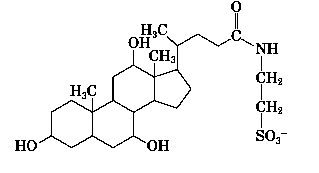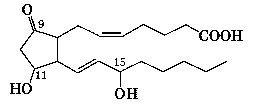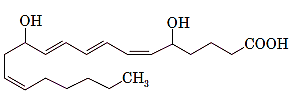
Concept explainers
(a)
Interpretation:The type of compound represented by the following compound needs to be determined:

Concept Introduction: The characterization of steroids is done by the presence of four ring structures arranged in a specific configuration in the compound. They are found in the cell membrane and influence the fluidity of the membrane. They work by decreasing inflammation and reducing the activity of the immune system.
(b)
Interpretation: The type of compound represented by the following compound needs to be determined:

Concept Introduction: The group of compounds with varying hormones is said to be prostaglandins. They are derived enzymatically from the fatty acid.
(c)
Interpretation: The type of compound represented by the following compound needs to be determined:

Concept Introduction: The group of compounds with varying hormones is said to be prostaglandins. They are derived enzymatically from the fatty acid.
(d)
Interpretation: The type of compound represented by the following compound needs to be determined:

Concept Introduction: The group of compounds with varying hormones is said to be prostaglandins. They are derived enzymatically from the fatty acid.
Want to see the full answer?
Check out a sample textbook solution
Chapter 20 Solutions
Introduction To General, Organic, And Biochemistry
- How do organic compounds differ from inorganic compounds?arrow_forwardWhat molecule is shown in the figure? HO CH3 O a steroid molecule O a fatty acid molecule O a phospholipid molecule a fat molecule H₂C CH3 CH3 CH3arrow_forwardProvide the correct systematic name for the compound shown here. F OHarrow_forward
- Provide the correct systematic name for the compound shown here. OH s OHarrow_forwardthe smallest part of a compound that retains the property of the compound is called an?arrow_forward7. In the following images, identify at least two functional groups attached to each substance (by circling them), and name these chemical groups. You cannot name the same chemical group more than once OH S-CH3 CH3 H3C CS-H CH3 OH Leta 113 -CH3 +++ OH OH 1₂Narrow_forward
- What is the nomenclature of the following compound?arrow_forwardFunctional Groups FUNCTIONAL GROUPS IN ORGANIC CHEMISTRY FUNCTIONAL GROUPS ARE GROUPS OF ATOMS IN ORGANIC MOLECULES THAT ARE RESPONSIBLE FOR THE CHARACTERISTIC CHEMICAL REACTIONS OF THOSE MOLECULES. IN THE GENERAL FORMULAE SHOWN BELOW FOR EACH FUNCTIONAL GROUP, 'R' REPRESENTS THE REST OF THE MOLECULE, AND X REPRESENTS ANY HALOGEN ATOM. HALOGEN HETEROATOMICS CARBONYL COMPOUNDS HYDROCARBONS SIMPLE OXYGEN HETEROATOMICS NITROGEN-BASED SULFUR-BASED AROMATIC R-OH 0-R₂ R-X ALKANE ALKENE ALKYNE EPOXIDE Noming one egethane Noming ene egethene Noming ye ALCOHOL Naming-of egethanol ETHER Naming-ory ane eg. methoxyethane Naming ene oxide egethene oxide HALOALKANE Naming: holo eg. chloroethane eg ethyne ÅR (PNP) -Å-X OR₂ ALDEHYDE Naming al eg ethanal KETONE Naming: one eg propanone CARBOXYLIC ACID Naming oic acid eg, ethanoic acid ACID ANHYDRIDE Noming oic anhydride eg. ethanoic anhydride ESTER Naming late eg. ethyl ethanoate AMIDE Naming: amide eg. ethanamide ACYL HALIDE Naming ay halide eg…arrow_forwardArrange the following sets of compounds based on the property given in increasing order. Type in the number of the compound to the corresponding roman numeral, I being the lowest and IV being the highest. pka CH;COOH HCOOH CICOOH CH;OH 1 2 3 4 I (lowest)arrow_forward
 General Chemistry - Standalone book (MindTap Cour...ChemistryISBN:9781305580343Author:Steven D. Gammon, Ebbing, Darrell Ebbing, Steven D., Darrell; Gammon, Darrell Ebbing; Steven D. Gammon, Darrell D.; Gammon, Ebbing; Steven D. Gammon; DarrellPublisher:Cengage Learning
General Chemistry - Standalone book (MindTap Cour...ChemistryISBN:9781305580343Author:Steven D. Gammon, Ebbing, Darrell Ebbing, Steven D., Darrell; Gammon, Darrell Ebbing; Steven D. Gammon, Darrell D.; Gammon, Ebbing; Steven D. Gammon; DarrellPublisher:Cengage Learning Chemistry: The Molecular ScienceChemistryISBN:9781285199047Author:John W. Moore, Conrad L. StanitskiPublisher:Cengage Learning
Chemistry: The Molecular ScienceChemistryISBN:9781285199047Author:John W. Moore, Conrad L. StanitskiPublisher:Cengage Learning Chemistry: Principles and ReactionsChemistryISBN:9781305079373Author:William L. Masterton, Cecile N. HurleyPublisher:Cengage Learning
Chemistry: Principles and ReactionsChemistryISBN:9781305079373Author:William L. Masterton, Cecile N. HurleyPublisher:Cengage Learning


